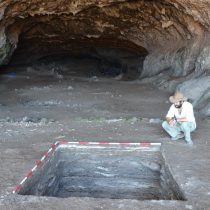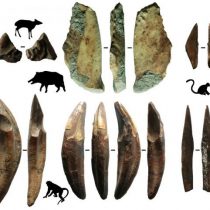Microliths — small, retouched stone tools — found in a Sri Lankan cave are the earliest evidence of such advanced technology in South Asia, according to a study released October 2, 2019 in the open-access journal PLOS ONE by Oshan Wedage of the Max Planck Institute for the Science of Human History in Germany and colleagues.
In the past, tropical rainforests have been thought of as a barrier to early human dispersal, being difficult to inhabit and to traverse compared to the environments of Europe and Africa. This view has been overturned by recent discoveries of rainforest cultures in South Asia dating as early as 45,000 years ago, but uncertainty still exists about what kind of technology allowed early cultures to survive in these habitats.
In this study, Wedage and colleagues analyze microliths from the Sri Lankan cave site of Fa-Hien Lena, dating between 48,000 and 45,000 years old. Microliths are considered to be the product of composite weapons produced by cultures with advanced strategies for hunting and thriving in challenging environments. Such tools are known from European sites of this age, but this is the oldest microlith assemblage in South Asia and the oldest known from a rainforest environment.
The authors suggest that these tools were likely part of composite projectile technology used to hunt and capture tree-dwelling prey, though more research will be needed to confirm their exact functions.
The similarity of Fa-Hien Lena technology to that of local cultures as recent as 4,000 years old reflects a long-term stability in rainforest technology in the region. This technology, along with the rise of more complex social structures, may have been part of the ‘toolkit’ that allowed Late Pleistocene humans to spread to nearly every environment on the planet.
Wedage summarizes: “We undertook detailed measurements of stone tools and reconstructed their production patterns at the site of Fa-Hien Lena Cave, the site with the earliest evidence for human occupation in Sri Lanka. We found clear evidence for the production of ‘miniaturised’ stone tools or ‘microliths’ at Fa-Hien Lena, dating to the earliest period of human occupation.”
![Fa-Hien Lena site stratigraphy. A) South wall end of the 2010 excavation taken from Wedage et al. [26]; B) South wall end of the 2012 excavation. Colours represent Munsell colour values of sediments. Phases D, C, B, and A, and their associated radiocarbon age brackets (see also [26]). Yellow star shows human fossil identified by Kennedy [27], see also Wedage et al. [26]. Credit: Wedage et al, 2019](https://www.archaeology.wiki/wp-content/uploads/2019/10/Fa-Hien-Lena-site-stratigraphy-1200x1091.jpg)




